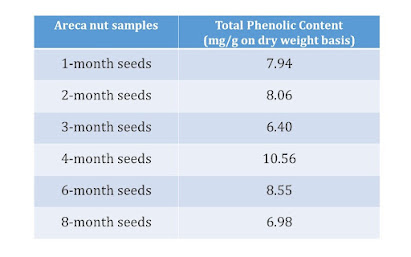Areca nut
contains a large number of phenolic compounds in substantial quantity.
Flavonoids (flavones, flavanones, flavanols, flavonols), phenolic acids and
polyphenols (procyanidins, areca tannins etc.) are some of the important
classes of phenolic compounds found in areca nuts. These compounds are
responsible for the dark brownish color in the boiled nuts (Red supari). They
impart astringent taste, and they turn red in the presence of lime. Most
of the perceived therapeutic properties of areca nut are attributed to these
flavonoids, phenolic acids and polyphenols. Almost all of them are highly
potent antioxidants. A brief account of proven health benefits of some of the
prominent phenolic compounds present in areca nut shall be posted in subsequent
Blogs.
Very few
reports are available on the systematic study of total phenolic compounds
present in the areca nuts at its developmental stages. A brief account of those
reports is presented below.
Thailand
Total
phenolic content of areca nuts cultivated in Nakhon-Pathom province of Thailand
was estimated by Wetwitayaklung et al., (2006).
They have used a standard method to extract and analyze the phenolic
content of areca nuts of maturity 1 month to 8 months. They have reported that
the total phenolics is in the range of 8 mg/g (by weight on dry basis) in the
1-month-old nut, reaches 10.5 mg/g at the 4th month and reaches 7 mg/g in the
8th month areca nut. The results of their study are presented below.
Indonesia
One more
recent study on the estimation of chemical constituents of areca nuts was
reported from Indonesia. Sari et al., (2020) had studied the total phenolic
content of unripe (green) areca nuts (6-7 months’ maturity) collected from West
Kalimantan and West Papua and ripened areca nuts (perhaps 9-10 months’
maturity), collected from Banda Aceh & North Sumatra, Indonesia. The
phenolic content was in the range of 10.88 mg/g to 21.67 mg/g on dry weight
basis. The unripe (green) nut collected from West Papua province of Indonesia
had the highest phenolic content 21.67mg/g on dry basis, whereas the unripe
(green) nuts from West Kalimantan had only 10.8 mg/g of Phenolic compounds. The
mature areca fruits from North Sumatra & Banda Aceh had phenolic content of
11.1 mg/g & 12.2 mg/g respectively.
China
A recent
study on the total phenolic present in the areca nuts of 5 months maturity has
been reported by Song et al., (2022). They had chosen the areca nut samples
from Hainan Province of China and they analysed the phenolic content of the
seed after separating the husk. They reported the total phenolic content of
36.3 mg/g on dry weight basis. In another study, Wang et al., (2023) had analysed
the total phenolic content of areca nut (with husk) of 5 months maturity, collected
from 11 prominent areca growing regions of Hainan Province of China. They had
used High Performance Liquid Chromatography (HPLC) method to determine the
phenolic content. They have reported an average value of 36 mg/g (on dry weight
basis). As they had estimated the Phenolic content of areca nut along with the husk,
the values seem to be highly inflated.
From the aforesaid literatures, it is clear that there is a great variability in their concentrations in areca nuts cultivated in different regions of the world. The values varied from 6.98 mg/g (8-month sample from Thailand) to 36.3 mg/g (5-month sample from China). The unripe (green) areca nuts of 4 to 5 months maturity have the highest concentration of Phenolic compounds. Interestingly, the areca nut of 4-5 months maturity is harvested and processed to make flavoured Bing lang in China (Refer my Blog No. 6 & 7 under the label “Global areca nut production”).
References:
1. 1. Wetwitayaklung et al., (2006). The study of
antioxidant capacity in various parts of Areca catechu L. Naresuan
University Journal, Vol. 14 (1), pp. 1-14.
2. 2. Sari et al., (2020). Distinct phenolic, alkaloid and
antioxidant profile in betel quids from four regions of Indonesia, Scientific
Reports, Vol. 10:16254
3. 3. Song et al., (2022). UHPLC-MS/MS identification,
quantification of flavonoid compounds from Areca catechu L. extracts and in
vitro evaluation of antioxidant and key enzyme inhibition properties involved
in hyperglycemia and hypertension. Industrial Crops & Products. Vol. 189,
pp. 115787.
4. 4.Wang et al., (2023). Evaluation of Areca Quality Based
on Principal Component and Hierarchical Cluster Analyses in Hainan, China.
HORTSCIENCE, Vol. 58(6), pp. 699–703.




